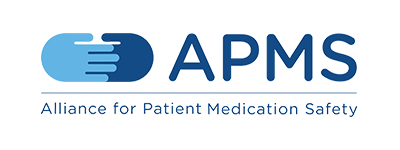Mistake-proofing a Hole in the Safety Net
 Highlights of Evidence-based Practices to Reduce Point of Sale (POS) Errors
Highlights of Evidence-based Practices to Reduce Point of Sale (POS) Errors
This article was written by APMS PSO staff in consultation with its Chief Medication Safety Officer, John M. Kessler, BS Pharm., PharmD.
Find quick recommendations and self-assessments at the end of this article to share with your pharmacy team!
The pharmacist hangs up the phone in disbelief after hearing from a long-time patient that her husband is in the hospital. He was dizzy and nauseous the night before, and when his wife looked at the Rx vial, she realized that there was someone else’s name on his prescription. The pharmacist’s gut clenches as she wonders, “ We have safety checks, how could we have given a long-time patient the wrong medication?”
You are careful, but mistakes happen. This article will summarize four primary strategies to reduce the risk of POS errors and offers some practical suggestions to reduce the chance of an error happening in your pharmacy and reaching the patient.
Point of Sale (POS) errors are fundamentally defined as “wrong patient” errors due to a mix-up in which prescriptions are bagged and dispensed to a patient. Depending on the pharmacy’s workflow, POS errors can occur when the prescription is handed to the wrong patient or, earlier in the process. For example, when a medication is placed in the wrong patient’s bag, when medications from two or more patients are placed in the same bag, or an intended medicine is omitted from the bag and fails to be dispensed. Additional errors can occur when the bag contains the patient leaflet intended for a different patient. Also, misreading the bag, or the patient identifiers, can result in POS errors. Regardless of the cause, the safety steps to prevent and detect these errors before they reach the patient and cause harm are similar.
To reduce the chance of a medication error, integrate some of these safety tactics into your pharmacy’s workflow.
- Establish policies and procedures that focus on preventing error such as standardized workflow with built-in redundancies, checklists, and reminders
- Automation and implementation of “hard stops”
- Forcing functions that do not allow advancement of a task without additional verification steps1, including POS bar code verification prior to completing the sale/transfer to the patient. (*Forcing functions are highest on the spectrum of effectiveness while standardization of procedures is ranked moderately high in its ability to prevent errors from reaching the patient*)
|
Note: keep in mind that in this article, the use of automated technologies that link the register sale to the dispensing computer, in safety terms, is a “forcing function”. A detailed review of intake and filling errors that occur earlier in the dispensing workflow have been intentionally excluded from this brief POS review. |
The absence of standardized procedures for the pharmacist, technician, and register clerk results in the inability to expect improvement in rates of POS errors. A shared understanding among the entire pharmacy team of medication safety policies and procedures is key.
While the pharmacy may have implemented safety checks to prevent mix-ups, the effectiveness of the strategies is only as good as the overall compliance in using each check. Some questions the pharmacist could ask are below:
- Is everyone in the pharmacy aware of the safety policies and procedures?
- Are they followed, or have work-arounds and short cuts replaced them in everyday operations?
- Does the overriding culture in the pharmacy focus on safety or has a competing focus resulted in unconscious support and encouragement of shortcuts and workarounds that deviate from policies and procedures?
The pharmacy manager or safety officer could conduct discrete direct observations of the actual workflow from receipt of the prescription through dispensing/counseling, noting variations in practice or deviations from standardized procedures.
Self-Assessments and Recommendations
Below are recommendations and suggestions for your pharmacy, with a corresponding self-assessment checklist for each, that may help you determine some areas for improvement. Here are some tips on how to tackle self-assessments efficiently so that you can begin implementing effective safe practices into your pharmacy workflow:
- Set aside adequate time for the assessment. This is a time for thoughtful, honest reflection and evaluation of your pharmacy and pharmacy team.
- Be prepared with a writing utensil and a hard-copy for answers, notes, and ideas.
- Be ready and excited to implement some tools and best practices into your workflow and to reduce the risk of POS errors in your pharmacy!
- Dispensing/fill baskets are recommended practices to keep the prescription workflow area organized while minimizing the risk that the wrong product becomes part of a different patient’s supply. The basket system is critical when more than one patient’s medications are prepared on the same counter at the same time. Each patient must have their own basket – with NO exceptions (e.g., for twins/siblings; spouses/partners; parent/child), even if 2 patients’ prescriptions are on the same written/faxed order. Keep in mind that baskets can help organize the work-counter; however, their safety value is easily defeated if any stock is allowed to be placed on the counter outside a basket, or unlabeled vials are placed in the workflow, or vials and labels are not kept within the basket; or there is no single pharmacist or technician who can claim “ownership” of a given basket before it is handed-off to the next workflow step.
Pharmacy has a standardized written procedure for:
- Use dispensing/filling baskets for every patient (regardless of the number of prescriptions being filled).
- Ensure that each pharmacist and technician processes only a single patient’s prescriptions at a time.
- Ensure that each basket is “owned” by a designated pharmacist or technician at a stage in the workflow.
- Ensure that baskets are appropriately sized and not stacked or nested in a manner that would allow a vial or label to fall or “spill” into another patient’s basket.
- Patient counseling is a multi-step process that includes:
- determining when counselling is needed,
- the quality of the professional counselling,
- the patient’s comprehension of the information; and
- achieving expected patient behaviors.
A discussion of the counseling process itself is beyond the scope of this brief. Most importantly, none of the above steps will be relevant if the patient does not accept an offer to counsel. Therefore, improving the effectiveness of patient counseling begins with increasing the number of patients who accept offers for counseling. Counseling is expected to improve the accuracy of the patient’s medication list and detect medication related problems such as therapeutic duplication, interactions, allergies, excessive medication use, problems with medication adherence and disease prevention measures, such as improving the vaccination rate for pediatric and adult patients. Counseling is also expected to detect potential medication errors before they “reach the patient”. Root cause analysis of serious medication errors has demonstrated that even the most basic information exchanged during a counseling session would have alerted the patient or the pharmacist to prescribing and dispensing errors, including wrong drug, wrong dose, wrong frequency, wrong patient, drug allergy and drug interactions. The primary quality improvement outcome is to measure the patient acceptance rate of the offer to counsel and then continuously increase that rate.
Pharmacy has a standardized written procedure for patient counseling and:
- The will-call/pick-up location has adequate privacy protections to promote counseling.
- The offer to counsel is made in a positive manner, encouraging the patient to accept.
- The pharmacy teaches and uses scripted language to encourage acceptance of the offer to counsel.
- Such phrases include:
- “The pharmacist would like to talk with you about a change in your prescription”.
- “The pharmacist would like to talk with you about some important new information
- about your prescriptions”.
- “The pharmacist would like to discuss with you some important safety information
- about your prescription”.
- The pharmacist flags the prescription bag in an obvious manner to inform the clerk that the pharmacist must speak with the patient.
- The pharmacy has a procedure to require pharmacist counseling for selected medications or changes in the prescription including narrow-therapeutic index drugs; high alert drugs, pediatric patients; complex dosing or administration instructions; and changes in dose.
- The pharmacy uses a “triaged” approach to counseling (vs an “all-or-none” plan), applying professional judgment to determine when and how much information should be disclosed during the counseling session.
- Patients are encouraged to ask questions or raise concerns, even after leaving the pharmacy.
- Patient questions, either in person or over the phone are always treated with respect and taken seriously
- Open the bag (a.k.a Show and Tell) “Mix-ups” can occur when a correctly verified prescription is placed in the bag for a different patient. Once “bagged”, a high percentage of these errors will reach the patient. Opening the bag and showing the patient at the time of pickup can decrease most types of mix-up errors by more than 50%. This is a “safe-transfer” strategy that is independent from patient counseling; the latter which can only be conducted or supervised by a pharmacist. The “show and tell” method is further enhanced when the patient becomes a partner is assuring their own safety and asked to confirm the dispensed prescriptions (drug, dose, and directions) are the expected items. When used in combination with other safety strategies, the risk of an error reaching the patient drops even further. While mix-ups can occur with any drug and with any patient, a triaged strategy would focus on prescriptions with a greater risk of causing harm. Pharmacies should develop mandatory “open the bag” policies for pediatric prescriptions and high alert medications, with notable examples including warfarin, insulins, hydralazine/hydroxyzine, and methotrexate.
Pharmacy has a standardized written procedure to open, review, and show bag contents to patient
The will-call/pick-up location has adequate privacy protections to enable the pharmacy employee to “show, tell, and discuss” with the patient.
- At the time of pick-up, in the presence of the customer and with the customer’s involvement, or prior to home delivery with a second person, the bag is opened, and the contents matched to the receipt, inspecting for omitted or extra items.
- The patient is asked to confirm if these are the prescriptions and doses they expected. At any hint of concern or question, automatic pharmacist review is required.
- Written medication guides and/or leaflets are included and matched with each prescription dispensed.
- Patients are encouraged to ask questions or raise concerns, even after leaving the pharmacy.
- There is a defined list of high alert medications that require an “open the bag” procedure.
- All pediatric prescriptions, new and refills, require an “open the bag” procedure.
- Patient identification procedures Adopting a standardized 2-identifier procedure is an evidence-based practice to reduce the risk of mix-ups at the POS. Improving the accuracy of the practice is an appropriate strategic target for quality improvement. Weak and error-prone identification procedures will:
1) fail to have the patient state their name and identifiers, or
2) allow employees to use their “judgment” in deciding when to apply the procedure, or
3) assume another employee has already checked the patient’s identity. The pharmacy’s 2-identifier procedure should define the acceptable identifiers.
The 2 most acceptable are the patient name (first and last) and the date of birth (not age). Phone numbers and addresses are not reliable primary identifiers and should be avoided or used only as a 3rd confirming identifier in select situations. At a minimum, employees should be trained to:
1) use auditory and visual cues to detect identification errors, and
2) say “for your safety” as part of a verbal script to help the patient understand, minimizing any potential social awkwardness for regular customers, and
3) integrate the 2-identifier procedure into the “show and tell” procedure for maximum efficiency.
Each pharmacy has strategies and procedures to increase compliance with patient identification procedures
The pharmacy requires employees to ask for and the patient to identify themselves using 2 unique identifiers at the time of pick-up.
- Pharmacy employees are trained on the contributing factors that often lead to patient-mix ups. Examples include: patients with similar names living at the same address, failing to ask patients to actively state their identifiers (vs. responding to a name called out by the pharmacy from the pick-up window); prescription pick-up for more than one person in the household (e.g. siblings, twins, father- son/mother-daughter); patients with compound family names (common in Latino, South American, and Middle Eastern cultures); and prescriptions for persons with intellectual or cognitive disabilities.
- Pharmacy employees are empowered with a pharmacy “safety rule” that requires the patient to disengage from a cell phone call during the patient identification and pick-up process. (Signage signifying mandatory “cell phone free” zone to ensure patient safety.
- Pharmacy Times. April 1, 2007 Michael J Gaunt, PharmD The Best Error-prevention Tools for the Job
The mission of APMS® is to foster a culture of quality within the profession of pharmacy that promotes a continuous systems analysis to develop best practices that will reduce medication errors, improve
medication use and enhance patient care. Pharmacies work with APMS® to look for inherent risks in the pharmacy’s workflow. Their program, Pharmacy Quality Commitment +TM (PQC+) is an interactive CQI
program that provides tools and resources for the pharmacy workforce to identify, report, and analyze
quality-related patient safety events. APMS is a 501 c 3 supporting organization of the National Alliance of State Pharmacy Associations.












